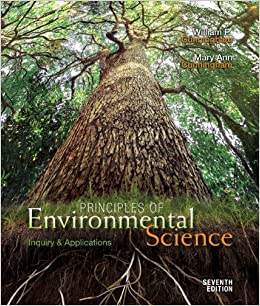
Principles of Environmental Science 7th Edition by William Cunningham,Mary Cunningham
Edition 7ISBN: 978-0071314947
Principles of Environmental Science 7th Edition by William Cunningham,Mary Cunningham
Edition 7ISBN: 978-0071314947 Exercise 2
Suppose you wanted to study the environmental impacts of a rich versus a poor country. What factors would you examine, and how would you compare them?
Explanation
Certain vital substances are concentrated within cells, while others are actively excluded. Out of which carbon is a particularly important element because chains and rings of carbon atoms from the skeletons of organic compound, the material of bio-molecules, and therefore living organism, are made. The four major categories of bio-molecules are lipids, carbohydrates, proteins, and nucleic acid.
• Lipids: lipids including fats and oil store energy for cells, and provide the core of cell membrane and other basic structure, and together with many hormones are also lipids.
• Carbohydrate: carbohydrate including sugars, starches, and cellulose also store energy and provide structure to cell. Like lipids and carbohydrate have a basic structure of carbon atoms.
• Proteins: proteins are composed of chains of subunits are called amino acids. Proteins provide structure to cells and are used for countless cell functions. Enzymes, such as those that release energy from lipids and carbohydrate, are proteins. Proteins help to identify disease-causing microbes, make muscles move, transport oxygen to cells, and regulate cell activity.
• Nucleic acid: Nucleotides are complex molecule made of a five-carbon sugar (ribose or deoxy-ribose), one, or more phosphate groups, and an organic nitrogen containing base. Nucleotides also form long chains called ribonucleic acid (RNA) with ribose sugar, and deoxy-ribonucleic acid (
 ) with deoxy-ribose sugar.
) with deoxy-ribose sugar.
Here we see that proteins, lipids, sugars, and nucleic acids that keep our life alive mainly contain carbon, oxygen, nitrogen, hydrogen, and phosphorous.
The basic structure of cell these four types of bio-molecules. All these molecules contain carbon atom as a backbone in their structure, thus the carbon have been a part of the body and a prehistoric creature.
• Lipids: lipids including fats and oil store energy for cells, and provide the core of cell membrane and other basic structure, and together with many hormones are also lipids.
• Carbohydrate: carbohydrate including sugars, starches, and cellulose also store energy and provide structure to cell. Like lipids and carbohydrate have a basic structure of carbon atoms.
• Proteins: proteins are composed of chains of subunits are called amino acids. Proteins provide structure to cells and are used for countless cell functions. Enzymes, such as those that release energy from lipids and carbohydrate, are proteins. Proteins help to identify disease-causing microbes, make muscles move, transport oxygen to cells, and regulate cell activity.
• Nucleic acid: Nucleotides are complex molecule made of a five-carbon sugar (ribose or deoxy-ribose), one, or more phosphate groups, and an organic nitrogen containing base. Nucleotides also form long chains called ribonucleic acid (RNA) with ribose sugar, and deoxy-ribonucleic acid (
 ) with deoxy-ribose sugar.
) with deoxy-ribose sugar. Here we see that proteins, lipids, sugars, and nucleic acids that keep our life alive mainly contain carbon, oxygen, nitrogen, hydrogen, and phosphorous.
The basic structure of cell these four types of bio-molecules. All these molecules contain carbon atom as a backbone in their structure, thus the carbon have been a part of the body and a prehistoric creature.
Principles of Environmental Science 7th Edition by William Cunningham,Mary Cunningham
Why don’t you like this exercise?
Other Minimum 8 character and maximum 255 character
Character 255


